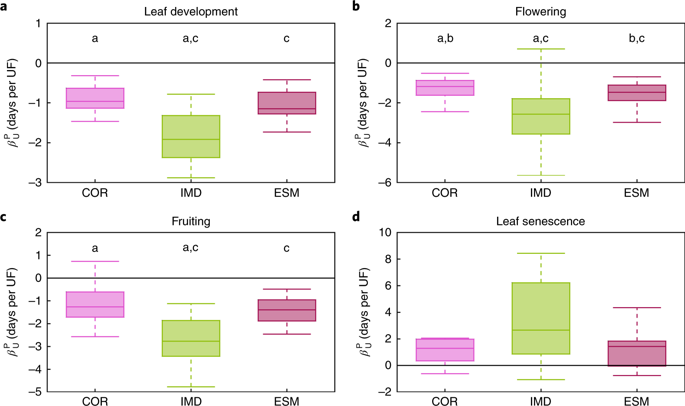当前位置:
X-MOL 学术
›
Nat. Ecol. Evol.
›
论文详情
Our official English website, www.x-mol.net, welcomes your
feedback! (Note: you will need to create a separate account there.)
The urban imprint on plant phenology.
Nature Ecology & Evolution ( IF 13.9 ) Pub Date : 2019-11-11 , DOI: 10.1038/s41559-019-1017-9 Georg Wohlfahrt 1 , Enrico Tomelleri 2 , Albin Hammerle 1
Nature Ecology & Evolution ( IF 13.9 ) Pub Date : 2019-11-11 , DOI: 10.1038/s41559-019-1017-9 Georg Wohlfahrt 1 , Enrico Tomelleri 2 , Albin Hammerle 1
Affiliation

|
The modification of the surface radiation and energy balance in urban areas causes the temperatures in these areas to exceed those of the surrounding countryside. It has thus been suggested that urban environments may serve as field laboratories for studying the effects of a warming climate on biota in a space-for-time substitution. Here we investigated changes in the timing of plant phenology and temperature across study sites that differed in the degree of urbanization using publicly available pan-European datasets for the period 1981-2010. We found a significant advancement in the phenological phases of leaf development, flowering and fruiting with higher degrees of urbanization, whereas a significant delay was observed for phenological phases of leaf senescence. In addition to these phenological changes, an increase in air temperature with higher degrees of urbanization was observed. This increase was largest during the periods of leaf development, flowering and fruiting and smallest during the period of leaf senescence. On the basis of these results, we show that the apparent temperature sensitivity of phenological phases to urban warming is either significantly dampened (leaf development, flowering and fruiting) or reversed (leaf senescence) compared with the temperature sensitivity inferred from temporal changes in phenology and temperature. We conclude that gradients in urbanization represent a poor analogue for the temporal changes in plant phenology, apparently owing to confounding factors associated with urbanization.
中文翻译:

城市在植物物候学上的烙印。
城市地区表面辐射和能量平衡的改变导致这些地区的温度超过周围乡村的温度。因此,有人提出,城市环境可以作为实地实验室,以时空替代的方式研究气候变暖对生物群系的影响。在这里,我们使用公开的泛欧洲数据集(1981-2010年)调查了各个研究地点的植物物候变化和温度变化的时间,这些变化的城市化程度有所不同。我们发现,随着城市化程度的提高,叶片发育,开花和结果的物候阶段有了显着的进步,而叶片衰老的物候阶段则观察到了显着的延迟。除了这些物候变化之外,随着城市化程度的提高,气温升高。这种增加在叶片发育,开花和结果期间最大,而在叶片衰老期间最小。根据这些结果,我们发现,与从物候和温度的暂时变化推断出的温度敏感性相比,物候期对城市变暖的表观温度敏感性显着减弱(叶片发育,开花和结果)或逆转(叶片衰老)。温度。我们得出的结论是,城市化的梯度代表了植物物候随时间变化的不良模拟,这显然是由于与城市化相关的混杂因素所致。开花结果,叶片衰老期间最小。根据这些结果,我们发现,与从物候和温度的暂时变化推断出的温度敏感性相比,物候期对城市变暖的表观温度敏感性要么显着减弱(叶片发育,开花和结果),要么逆转(叶片衰老)。温度。我们得出的结论是,城市化的梯度代表了植物物候随时间变化的不良模拟,这显然是由于与城市化相关的混杂因素所致。开花结果,叶片衰老期间最小。根据这些结果,我们发现,与从物候和温度的暂时变化推断出的温度敏感性相比,物候期对城市变暖的表观温度敏感性要么显着减弱(叶片发育,开花和结果),要么逆转(叶片衰老)。温度。我们得出的结论是,城市化的梯度代表了植物物候随时间变化的不良模拟,这显然是由于与城市化相关的混杂因素所致。与从物候和温度的时间变化推断出的温度敏感性相比,花期或果期)或逆转(叶衰老)。我们得出的结论是,城市化的梯度代表了植物物候随时间变化的不良模拟,这显然是由于与城市化相关的混杂因素所致。与从物候和温度的时间变化推断出的温度敏感性相比,花期或果期)或逆转(叶衰老)。我们得出的结论是,城市化的梯度代表了植物物候随时间变化的不良模拟,这显然是由于与城市化相关的混杂因素所致。
更新日期:2019-11-13
中文翻译:

城市在植物物候学上的烙印。
城市地区表面辐射和能量平衡的改变导致这些地区的温度超过周围乡村的温度。因此,有人提出,城市环境可以作为实地实验室,以时空替代的方式研究气候变暖对生物群系的影响。在这里,我们使用公开的泛欧洲数据集(1981-2010年)调查了各个研究地点的植物物候变化和温度变化的时间,这些变化的城市化程度有所不同。我们发现,随着城市化程度的提高,叶片发育,开花和结果的物候阶段有了显着的进步,而叶片衰老的物候阶段则观察到了显着的延迟。除了这些物候变化之外,随着城市化程度的提高,气温升高。这种增加在叶片发育,开花和结果期间最大,而在叶片衰老期间最小。根据这些结果,我们发现,与从物候和温度的暂时变化推断出的温度敏感性相比,物候期对城市变暖的表观温度敏感性显着减弱(叶片发育,开花和结果)或逆转(叶片衰老)。温度。我们得出的结论是,城市化的梯度代表了植物物候随时间变化的不良模拟,这显然是由于与城市化相关的混杂因素所致。开花结果,叶片衰老期间最小。根据这些结果,我们发现,与从物候和温度的暂时变化推断出的温度敏感性相比,物候期对城市变暖的表观温度敏感性要么显着减弱(叶片发育,开花和结果),要么逆转(叶片衰老)。温度。我们得出的结论是,城市化的梯度代表了植物物候随时间变化的不良模拟,这显然是由于与城市化相关的混杂因素所致。开花结果,叶片衰老期间最小。根据这些结果,我们发现,与从物候和温度的暂时变化推断出的温度敏感性相比,物候期对城市变暖的表观温度敏感性要么显着减弱(叶片发育,开花和结果),要么逆转(叶片衰老)。温度。我们得出的结论是,城市化的梯度代表了植物物候随时间变化的不良模拟,这显然是由于与城市化相关的混杂因素所致。与从物候和温度的时间变化推断出的温度敏感性相比,花期或果期)或逆转(叶衰老)。我们得出的结论是,城市化的梯度代表了植物物候随时间变化的不良模拟,这显然是由于与城市化相关的混杂因素所致。与从物候和温度的时间变化推断出的温度敏感性相比,花期或果期)或逆转(叶衰老)。我们得出的结论是,城市化的梯度代表了植物物候随时间变化的不良模拟,这显然是由于与城市化相关的混杂因素所致。











































 京公网安备 11010802027423号
京公网安备 11010802027423号